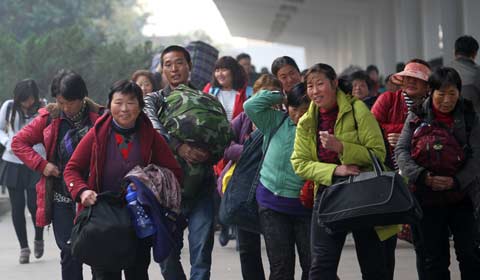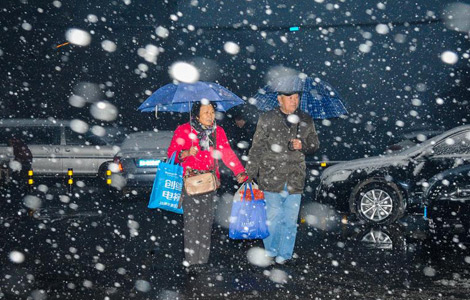Cultural exchange focuses on people, the way they write
Updated: 2013-11-20 12:56
By China Daily (China Daily USA)
|
||||||||
When we talk about cultural exchanges, most people think of government institutions sending big companies of performing artists abroad to stage grand extravaganzas in glamorous theaters in world capitals. Now there's another, more intimate way, one that makes direct people-to-people contact more a part of the process.
"If I were to hold a big gala with professional theatrical designs, the audience would feel a sense of distance between themselves and the artists," said Wei Ronghui, deputy curator of the Chinese National Museum of Ethnology (CNME), who is leading a delegation of artists from different Chinese ethnic groups on a tour of the US.
During their performance on Wednesday at Prince George's Community College (PGCC) in Maryland, the artists performed ethnic dances, gave a fashion show of ethnic costumes, demonstrated calligraphy and painting, and finally invited members of the audience up on the stage to let artists draw plum flowers, orchids, bamboos, and chrysanthemums - the four kinds of flowers valued in Chinese tradition for their personification of good character - on their T-shirts.
The tour, scheduled from Nov 9 to 19, is part of the cultural exchange program "Colorful China" initiated by the CNME. This is the group's third visit to the US after two successful tours in 2010 and 2011. This year's theme features Chinese ethnic scripts presented via artistic performance and displays of calligraphic works.
|
Performers from Chinese ethnic groups showcase written formats of their languages at Prince George's Community College in Largo, Maryland. Cai Chunying / China Daily |
The theme of ethic writing "allows the audience to interact with the calligraphers and the painters", said Wei, who thought that scripts, albeit abstract, would resonate with audiences because "written scripts are the common tools for all mankind to record their languages".
To Wei, cultural exchange is more about understanding than promotion. "I didn't like it when people in the past tried to promote Chinese culture and force foreign people to believe that Chinese culture is good. I think exchange and equal communication is more important, we communicate in the shared goal of enhancing mutual understanding between the Chinese and the American people," Wei said, adding that she wanted all the delegates to perform with love.
Unlike most delegations of their kind that usually stay in hotels, members of this group all stayed in American host family homes, so that they would have the opportunity to really experience American society and hopefully forge personal relationships that would last beyond their visit.
"Most of our artists don't speak English, so they communicate with their new family members by drawing pictures, and in that sense, they let art speak for itself," Wei said.
It worked. Wei said the host families and the delegates were crying in the morning when they had to say farewell. "The families all went out in the cold wind and wept. We experienced this on our past tours too," he said.
"The first day they arrived, they were with the host families all day. On the following day, we pulled them all together to learn traditional American square-dancing, they did taichi for us, and we had a typical American dinner together," said Betty McGinnis, president of World Artists Experiences, which sponsored the delegation and arranged their activities in the US. McGinnis said that wherever the delegation went, whether it was in communities, schools, or seniors homes, they were very well received.
World Artists Experiences consists of more than 3,000 volunteers assisting cultural exchange programs in 100 developing countries.
Deng Xianlai in Washington contributed to this story.
(China Daily USA 11/20/2013 page16)

 Death toll from typhoon Haiyan in Philippines tops 4,000
Death toll from typhoon Haiyan in Philippines tops 4,000
 Tourism year proves a big hit
Tourism year proves a big hit
 China is ready to send med team to Philippines
China is ready to send med team to Philippines
 150 years later, Lincoln's speech long remembered
150 years later, Lincoln's speech long remembered
 Girl's killer gives new evidence
Girl's killer gives new evidence
 Rural migrants set to benefit from country's urbanization reform
Rural migrants set to benefit from country's urbanization reform
 Harbin hit by heaviest snowfall since records began
Harbin hit by heaviest snowfall since records began
 Investing in rural teachers paying off
Investing in rural teachers paying off
Most Viewed
Editor's Picks

|

|

|

|

|

|
Today's Top News
Vice-Premier praises win-win ties
Billionaire ranks on rise
FDI grows steadily amid reform drive
China's reform is of significance to world
US ambassador to China resigns
Suning sets up R&D shop in California
Fosun to invest in US oil, natural gas sector
Japanese business leaders visit China
US Weekly

|

|







